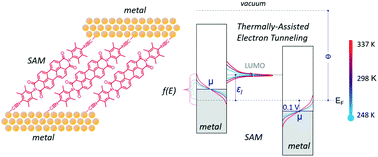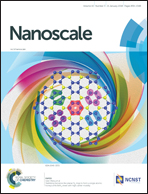Work function and temperature dependence of electron tunneling through an N-type perylene diimide molecular junction with isocyanide surface linkers†
Abstract
Conducting probe atomic force microscopy (CP-AFM) was employed to examine electron tunneling in self-assembled monolayer (SAM) junctions. A 2.3 nm long perylene tetracarboxylic acid diimide (PDI) acceptor molecule equipped with isocyanide linker groups was synthesized, adsorbed onto Ag, Au and Pt substrates, and the current–voltage (I–V) properties were measured by CP-AFM. The dependence of the low-bias resistance (R) on contact work function indicates that transport is LUMO-assisted (‘n-type behavior’). A single-level tunneling model combined with transition voltage spectroscopy (TVS) was employed to analyze the experimental I–V curves and to extract the effective LUMO position εl = ELUMO − EF and the effective electronic coupling (Γ) between the PDI redox core and the contacts. This analysis revealed a strong Fermi level (EF) pinning effect in all the junctions, likely due to interface dipoles that significantly increased with increasing contact work function, as revealed by scanning Kelvin probe microscopy (SKPM). Furthermore, the temperature (T) dependence of R was found to be substantial. For Pt/Pt junctions, R varied more than two orders of magnitude in the range 248 K < T < 338 K. Importantly, the R(T) data are consistent with a single step electron tunneling mechanism and allow independent determination of εl, giving values compatible with estimates of εl based on analysis of the full I–V data. Theoretical analysis revealed a general criterion to unambiguously rule out a two-step transport mechanism: namely, if measured resistance data exhibit a pronounced Arrhenius-type temperature dependence, a two-step electron transfer scenario should be excluded in cases where the activation energy depends on contact metallurgy. Overall, our results indicate (1) the generality of the Fermi level pinning phenomenon in molecular junctions, (2) the utility of employing the single level tunneling model for determining essential electronic structure parameters (εl and Γ), and (3) the importance of changing the nature of the contacts to verify transport mechanisms.



 Please wait while we load your content...
Please wait while we load your content...